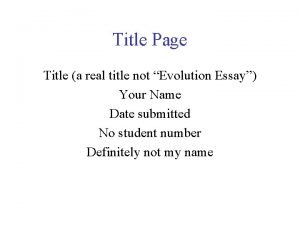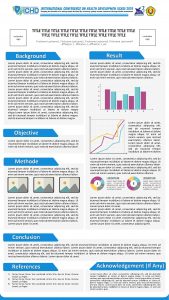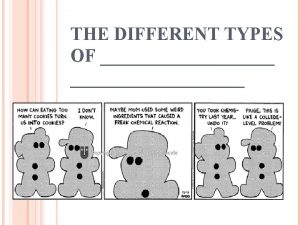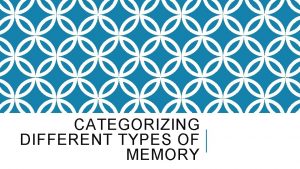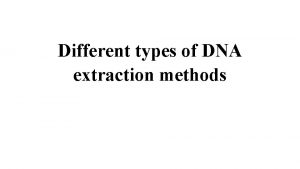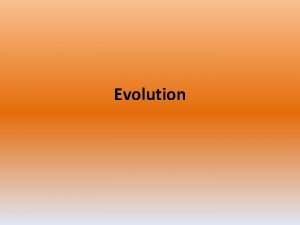Title Different Types of Evolution Learning question What

















- Slides: 17

Title: Different Types of Evolution Learning question: What are the different ways that evolution can occur? ?

Key words • • • • Divergent evolution Speciation Adaptation Common ancestor Adaptive radiation ous structures Convergent evolution analog Comparative anatomy Embryology Homologous structures Vestigial structures Analogous structures Molecular phylogeny bioinformatics

Divergent Evolution • A pattern of evolution where differences between groups of organisms accumulate to a critical point that leads to the development of a new species (speciation) • Genetic isolation can account for speciation • Organisms with a recent common ancestor adapt to suit their new environment via mutations over successive generations – divergence occurs • Development of various different species in this manner is referred to as adaptive radiation

Adaptive Radiation • Adaptive radiation is a pattern of divergent evolution – organisms rapidly diversify to adapt to new environment and niche • Tropical forests that covered central Australia gave rise to very different organisms that exist today. • Organisms compete to survive changing environment and divergent evolution led to other Australian mammals dominating the new environment. µ

Convergent Evolution • A pattern of evolution when unrelated organisms evolve similar adaptations in response to their environment e. g. ant eaters have developed similar structures • No recent common ancestor and belong to different orders • Traits and behaviors have developed independently and coincidentally • Analogous structures result from convergent evolution – adaptations of different types of structures that solve a problem in a similar way

Evidence for evolution: comparative anatomy • Examination of physical characteristics of species, studying: • Embryonic • Adult stages of evolution

Modern Life: Evidence for Evolutionary Change • Developmental biologists – study the stages of growth and development from fertilized egg until mature adult and beyond. – When embryos of organisms are similar, it shows that they are related because they have developed in similar ways.

Embryology • Embryology is a branch of developmental biology that focuses on the early development of organisms before they are born or hatched. • These developing organisms are known as embryos. • Embryology is particularly useful in studying organisms that can be grouped together as having a common ancestor and therefore finds out more about their evolutionary past.

Homologous structures • Homologous structures are structures derived from a common ancestor or same evolutionary or developmental origin. • Homologous structures may not necessarily perform the same function but they share a common ancestral origin. • For example, the forelimbs of humans and bats are homologous structures. Although they are used differently, the basic skeletal structure is the same and they are derived from the same embryonic origin. • Their similarity in this regard could indicate a likely evolution from a common ancestor.


Vestigial Homologous Structures • Vestigial structures – useless structures that no longer have a function in one organism but may still function in a related organism. – Examples-snake legs, whale pelvis, eyes in blind salamanders, human tail bone, etc. • A pattern of similar characteristics for both homologous and vestigial structures, suggests how organisms are related. Click on the image of the flightless Cormorant to find out more about its vestigial structures.

Analogous structures • Features of organisms that have the same function, but not the same basic structure are described as analogous structures • E. g. bats, butterflies and birds all have wings, but no common ancestor. However, they have adapted to a similar environment • Evidence that they have evolved from distinct lines of evolution

Comparative genetics • Scientists also compare the DNA of organisms – DNA is found in the nucleus of every cell and contains all of the genes that give organisms their traits and proteins. – The more alike the DNA, the more related. – For example, Monkeys are 93% similar and Chimpanzee 96% to humans in terms of DNA.

Protein Conservation • Proteins that are well suited to their function are conserved, while others may evolve • Mutations may change functionality of proteins over time, however, some mutations may substitute one amino acid for another that is very similar in charge and shape

Genetic Comparison • A baseline rate of mutations will always occur within a population – can be measured within a species as the mutation rate • Comparison of genetics between two species can use mutation rates as a “clock” to estimate when in time these species diverged from common anscestor

Comparative Genomics • Bioinformatics digitally stores, retrieves, organizes and analyses data • Used to provide evidence for evolution through rapid analysis of data gathered • Data can be used to create molecular phylogenic trees (molecular phylogeny) to illustrate how genes evolve and are modified to give rise to different lineages

What does this Phylogenetic tree tell us about CCR 5 and HIV? Humans and other primates have closely related CCR 5 sequences. This means that the SIV viruses that infect non-human primates didn't have to mutate very much to be able to use human CCR 5 as a coreceptor and infect the human immune system.
 Costa level questions examples
Costa level questions examples Evolution title page
Evolution title page Cuadro comparativo e-learning m-learning b-learning
Cuadro comparativo e-learning m-learning b-learning Completing reports and proposals
Completing reports and proposals Title title
Title title Current question.title
Current question.title Why do different polymers have different properties
Why do different polymers have different properties Technicolor test
Technicolor test Sound will travel at different speeds in different mediums.
Sound will travel at different speeds in different mediums. Sound travels fastest through
Sound travels fastest through What is cultural relativism
What is cultural relativism Different angle different story
Different angle different story Acids and bases have two different faces
Acids and bases have two different faces Different materials have different
Different materials have different Different people different things
Different people different things Argumenterande tal struktur
Argumenterande tal struktur Present simple question words
Present simple question words Closed question and open question
Closed question and open question

